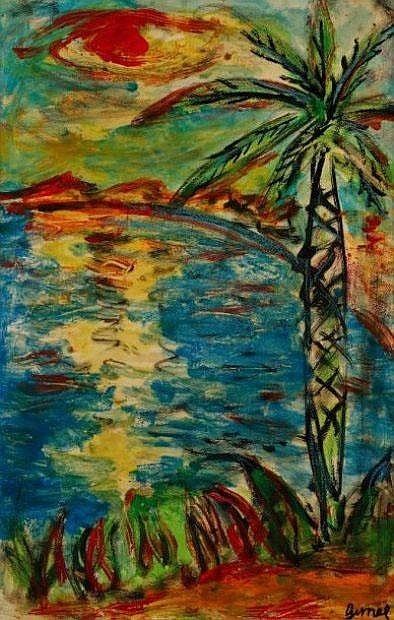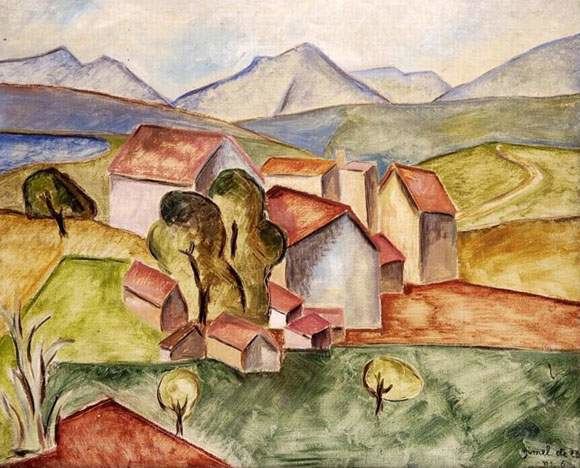Name Georges Gimel | ||
 | ||
Education Ecole nationale superieure des Beaux-Arts | ||
Georges Gimel (March 8, 1898 – January 21, 1962), was a French expressionist painter of portraits, landscapes, mountain landscapes, still lifes and flowers. He was also a wood carver, lithographer, illustrator, set designer, sculptor, and enamel painter.
Contents

Biography

Gimel was born at Domène (Isère), France. He lived at Domène and at Grenoble, where he studied at the Ecole des Arts Industriels, until the age of 16 at which time he moved to Paris. Gimel stayed in Paris for 20 years; thereafter he split his time between Megève, Annecy, Grenoble and Paris. He took part in both: the First World War and the Second World War.
In 1916 he studied at the École des Beaux-Arts of Paris, at the Studio of Jean-Paul Laurens and at the Ecole des Arts Décoratifs. After the war in 1919 he returned at the Ecole des Beaux Arts, at the Studio of Jean-Antoine Injalbert and at the same time he will become a pupil of the Académie Julian and also worked together with his warfriend the sculptor Henri Bouchard.
Gimel was the artistic director of the literary review Tentatives with Henri Petiot (Daniel Rops) for a special edition dedicated to Stendhal. He created numerous wood carvings, of which the portrait of Déodat de Séverac was owned by the Bibliothèque Nationale de Paris.
He took part in the Salon d'Automne and the Salon des Indépendants from 1921 until 1934. Gimel created the largest painting of the Salon d’Automne in 1927:” La cueillette des amandes”.
His talent was noticed very early on by Andry Farcy, curator of the Museum of Grenoble, who supported the “Peintres Modernes” and by the art critic Félix Fénéon.
Gimel’s lithographs sought after by collectors are composed of up to 14 colors. He worked as well on various works of portraiture as painting: winter landscapes, bathers, sports figures, flowers and marines. His life like characterizations and colors reflected himself.
An artistic dynamo, he linked the schools of beaux arts and commercial/artistic design: He created fabric designs for clothing designers Paul Poiret and Jean Patou.
In Paris, numerous exhibitions at the Art Gallery’s: Galerie Bernheim-Jeune, Galerie Bignou, Galerie Kleinmann, Galerie Berri-Raspail, Galerie Charpentier, Galerie Katia Granoff, gained him worldwide recognition.
In 1930, Gimel began to create immense frescoes such as the one at the principal office of the Société des Chaux et Ciment Lafarge a Paris.He got married with Madeleine Louise Jeannest at the Vésinet near Paris,in 1931. In 1933 he created a Station of the Cross which was controversial because of its modernism. His religious frescoes were exhibited at the Galerie Jean Charpentier, as well as the lithographs for Station of the Cross with an introduction by Léon Daudet in the Editions jeanne Bucher, in January 1934. One of this works will be owned by the Vatican and another by the Bibliothèque Nationale of Paris. Gimel’s work belongs to the school of religious art led by George Desvallières and Maurice Denis.
Architect Henry Jacques Le Même designed his chalet " La Fresque " at Megève and Gimel decorated the façades with avant-garde frescoes.
In 1937 Gimel took part in the Exposition Universelle de Paris and there he created the interior design for the Pavillon du Dauphiné.
At the end of World War II in 1944, his book Le Calvaire de la Résistance of pen and ink drawings of war scenes was published, some of which scenes had been exhibited at the Galerie Katia Granoff in Paris in April 1940.
Following this, he devoted himself to his art and to the making of his enamels where his genius allowed him to combine technical and practical aspects to create an indestructible form of enamel painting. In 1949, he exhibited 91 enamel works at the Art Gallery Bernheim Jeune in Paris. Later, thanks to the Ministère des Affaires Etrangères, several of his enamels were sent abroad to Rome (Italy) and Saarbrücken, (Germany) others were part of a traveling exhibition in the United States who started at the Yale University Art Gallery in 1954.
In 1956 Gimel created his Stations of the Cross in enamel for the church Jean-Baptiste at Megève. He also was asked by the Rotary-club des Alpes de Haute-Provence for a major conference on the subject of enamels, assisted by his friend Jean Giono. On January 21, 1962, a sunny Sunday, he died suddenly while ice skating with a young woman at the skating rink at Megève (Haute-Savoie).
